For decades, cheap flights, nightclubs and booze made Prague one of Europe’s stag party capitals. City officials have spoken out about tourists’ drunken behaviour, but Prague remains popular among men dressed as Smurfs drinking 50 koruna (£1.70) pints of pilsner.
I arrive on the train from Dresden, the German city just north of the Czech border, shortly before the launch of a new night train route. On 25 March the European Sleeper between Brussels and Berlin extends to Prague, arriving at Hlavní Nádraží, Prague’s main central station, at 10.56am.
I’m here to find the best things to do in the Czech Republic’s capital, and surrounding countryside, away from the city centre tourist sights.
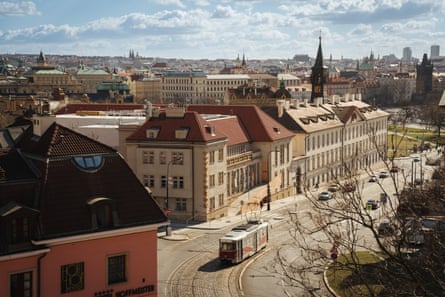
I’m staying at Miss Sophie’s Downtown hotel (huge rooms, exposed piping, staff who don’t mind me taking socially unacceptable amounts of boiled sweets from reception), just a five-minute walk from the station. I take a tram to Kunsthalle Praha art gallery to meet Ivana Goossen, director of the white-walled exhibition complex, which opened in 2022 and today resembles a dream-state library. I’d heard that in this city of flowing beer and grand museums, Kunsthalle represents a more contemporary side of Prague culture.
READ, a books-themed exhibition by Berlin-based artists Elmgreen & Dragset, has taken over most of the gallery and runs until 22 April. A sculpture of a chimp stands on a pile of hardbacks. Visitors peruse a display of progressive books banned in Florida. A man sitting alone at a long table calmly writes in a notebook. “What he’s doing is actually an art performance,” says Goossen.
Kunsthalle was converted from a 1930s electricity substation by local entrepreneurs Petr and Pavlína Pudil. Goossen says that after the 1989 Velvet Revolution, privately owned arts institutions were initially slow to emerge.
“There’s been a process of maturing,” she says. “Certain practices normal in the western world, where you see culture supported privately [with private investment in public art spaces], weren’t so typical. That’s changing, and people are recognising that Prague isn’t just about old architecture.”
Kunsthalle had about 110,000 visitors in its first year, attracting more local people than tourists. “We’re in the old centre, by the Prague Castle steps,” says Ivana, “but we’re showing that there is contemporary culture here.”
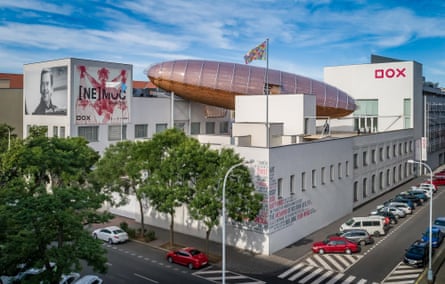
North of the centre, Holešovice, is one of Prague’s more gentrified districts, and home to the DOX Centre for Contemporary Art. I admire its moody nude sculptures before lunch at the newly opened Slice Slice Baby restaurant (recommended as “the best pizza slice in town” by one of Goossen’s colleagues). The pizza is excellent: co-owner Kateřina Jakusová tells me that the tomatoes are imported from Puglia.
A 30-minute tram ride south, the southern tip of Smíchov district is popular with artists but doesn’t yet have any hip pizzerias. A large parrot is gnawing a wooden door in the atrium cafe at MeetFactory: which is now a nonprofit artist space. The Shape of Water-esque sculptures here are great, but I don’t get properly sucked into the depths of artistic intrigue until I enter the gallery on the opposite side of the railway tracks. Musoleum opened in 2022 to showcase the work of Prague-born sculptor David Černý, who also founded MeetFactory. He’s known for his work Miminka, the freaky bulbous baby sculptures seen crawling up the city’s Žižkov Television Tower.
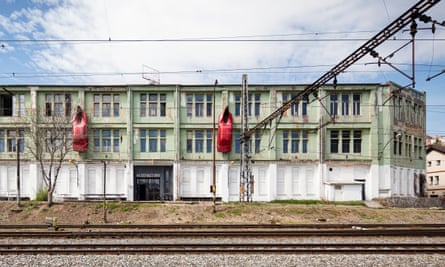
Car-sized handgun sculptures hang from the ceiling, and sporadic gunfire sounds make me jump every minute or so. A sculpture of a vintage car with human legs is overseen by a garish orange and blue Černý self-portrait. These brilliantly odd works are not suitable for kids or prudes though: one floor is dominated by enormous explicit moving human body part sculptures: Cronenberg via Razzle magazine.
Next day, I drive an hour and a half north to the – more family-friendly – Jiří Pačinek glass factory. Garish glass octopus sculptures protrude from soil in its “glass garden”. Inside, Pačinek, his 23-year-old son Jan and a few employees with metal rods are at work pulling molten glass from raging furnaces, and spinning bulbs so they solidify as vases.
The area has been known for fine glassmaking for centuries, and is still home to several glassworks. Pačinek is handing out bowls of boar stew. “The local hunter gave us the boar in exchange for some glass,” he says. “That’s how things work in the villages here, sometimes.”
after newsletter promotion
The Pačineks export their glass pieces globally, and tourists can try their hand at making glass souvenirs. The factory made the “crystal” sculptures for the 2022 film Glass Onion: A Knives Out Mystery. But despite that success, Jan says, fine Czech glasswork is under threat.
He nods towards a pair of employees gently curling molten glass threads around a vase. “These guys are about 50; young people don’t want to make glass any more. It’s a tradition in this area, but people want to work with computers.”
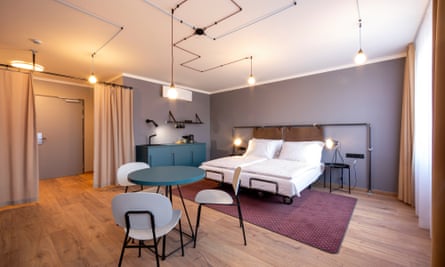
Pačinek rests his arm on his son’s shoulder. They tell how a huge local glasswork factory recently shut after 230 years, because of soaring energy costs. Pačinek’s gas furnaces have to be kept running constantly, at temperatures reaching 1,340C.
“I’m not afraid,” he says. “The small family companies will be the future, because when we see this problem with the energy prices it becomes something only for people who love this work. Which I think is perfect.”
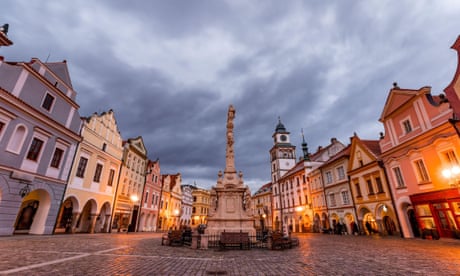
Jan shows me a glass gorilla head his father made, then a cluster of pieces inspired by the Covid-19 virus shape, made during lockdowns. I have a go at glass spinning and only manage an ugly glass globule. He smashes it. “Don’t worry, we can melt down the glass again.” I drive back to Prague with a signed beer glass his father made earlier.
On the train home, as I admire the smoothly rendered pint glass, I recall gallery director Goossen telling me: “Our joke went that Brits don’t think they’ve been to Prague, because they start drinking on the plane coming here and don’t sober up until the plane back.”
I won’t forget the friendly glassblowers, the door-gnawing parrot or the huge faceless babies quite so easily.
Train travel from London to Brussels was provided by Eurostar (from £39 each way). Travel from Brussels to Prague was provided by Omio, whose app allows travellers to compare different transport methods simultaneously. Accommodation in Prague was provided by Miss Sophie’s Downtown (doubles from €70, breakfast included if booking with the hotel directly) via Czech Tourism. Prague Visitor Pass provided by Czech Tourism. The European Sleeper train runs between Brussels Midi and Prague Hlavní Nádraží from 25 March 2024 (one-way couchette from €79)
